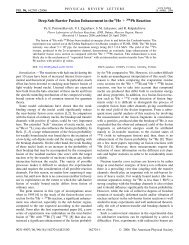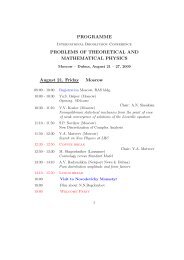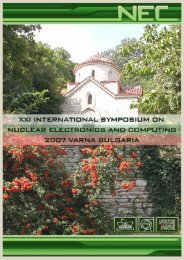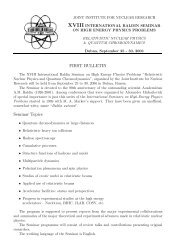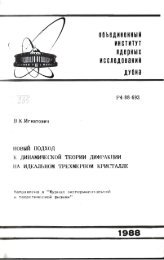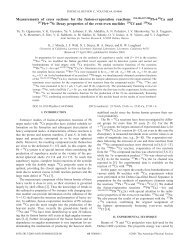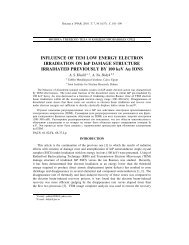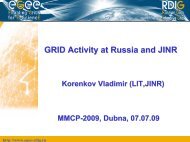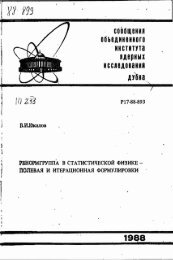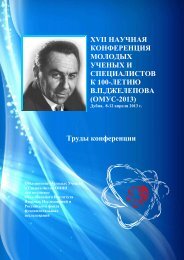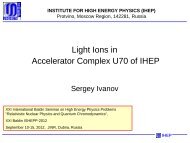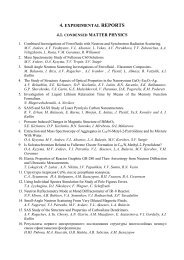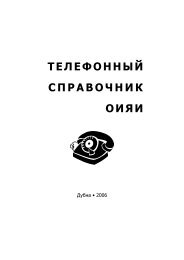Joint Institute for Nuclear Research Relativistic ... - Index of - JINR
Joint Institute for Nuclear Research Relativistic ... - Index of - JINR
Joint Institute for Nuclear Research Relativistic ... - Index of - JINR
Create successful ePaper yourself
Turn your PDF publications into a flip-book with our unique Google optimized e-Paper software.
ANALYSIS OF POTENTIAL ADVANCED THORIUM BASED FUEL FOR EPR<br />
REACTOR<br />
Marcin Szuta, Andrzej Wojciechowski<br />
National Centre <strong>for</strong> <strong>Nuclear</strong> <strong>Research</strong>, Poland<br />
Analysis <strong>of</strong> possible ways <strong>of</strong> reduction <strong>of</strong> radioactive wastes by transmutation <strong>of</strong><br />
radioactive long-lived fission products such as 99 Tc, 129 I and 135 Cs and by burning up <strong>of</strong><br />
transuranic nuclides implies that the reactor core should consist <strong>of</strong> three zones with fast,<br />
epithermal and thermal neutron spectra. High flux thermal neutron environment ( 10 16<br />
n/cm 2 s) is expected as the best way <strong>for</strong> the transmutation <strong>of</strong> most <strong>of</strong> the radioactive waste to<br />
stable or short-lived nuclides and <strong>for</strong> increasing the probability <strong>for</strong> fission such actinides as<br />
237<br />
Np and 238 Np.<br />
Since we are not able to construct such a reactor core with the three zones and we are not<br />
able to reach such an intense thermal neutron flux ( 10 16 n/cm 2 s) in terms <strong>of</strong> technical<br />
feasibility and in view <strong>of</strong> the inefficiency <strong>of</strong> actinides incineration <strong>for</strong> a low intensity thermal<br />
neutron flux, we focus our attention on the thorium-uranium fuel cycle as a prophylactic way<br />
<strong>of</strong> energy production where the radio-toxicity <strong>of</strong> the wastes is about three orders <strong>of</strong> magnitude<br />
smaller than in the case <strong>of</strong> classical PWR reactors.<br />
232<br />
Th is a better fertile material than 238 U in thermal reactors because <strong>of</strong> the three times<br />
higher thermal neutron absorption cross-section <strong>of</strong> 232 Th (7.4 barns) as compared to 238 U<br />
(2.7barns). Thus, conversion <strong>of</strong> 232 Th to 233 U is more efficient than that <strong>of</strong> 238 U to 239 Pu in<br />
thermal neutron spectrum.. The values <strong>of</strong> cross sections in brackets refer to the thermal<br />
neutrons.<br />
While the uranium 238-plutonium 239 fuel cycle requires fast neutrons to be sustainable,<br />
the thorium 232-uranium 233 fuel cycle is sustainable with either thermal neutrons or fast<br />
neutrons.<br />
As thorium based fuels have benefits in terms <strong>of</strong> radio-toxicity there are however<br />
challenges in terms <strong>of</strong> reprocessing the spent thorium based fuel. The database and experience<br />
<strong>of</strong> thorium fuels and thorium fuel cycles are very limited , as compared to UO 2 and (U,Pu)O 2<br />
fuels, and need to be augmented be<strong>for</strong>e large investments are made <strong>for</strong> commercial utilization<br />
<strong>of</strong> thorium fuels and fuel cycles.<br />
That is why, as the first step <strong>of</strong> studying the thorium application feasibility, once through<br />
thorium based fuel cycle analysis <strong>for</strong> energy production and radioactive waste transmutation<br />
was undertaken, which does not require the technically difficult reprocessing <strong>of</strong> the spent fuel.<br />
The idea is to analyze the thorium based fuel application in the open cycle feasibility<br />
study in the existing light water reactors with minimal modifications in order to exploit them.<br />
Preliminary analysis <strong>of</strong> thorium based fuel application in the EPR reactor have shown that<br />
once through thorium fuel cycle can be reached with difficulty. It is inferred that the 233 U<br />
concentration tends to saturation value which does not depend on power density while the<br />
kinetics <strong>of</strong> reaching the saturation value depends on it.<br />
Monte Carlo methodology calculations <strong>for</strong> the contribution to the analysis <strong>of</strong> thorium<br />
based fuel application in the EPR reactor and in the accelerated driven systems (ADS) were<br />
used.<br />
121



